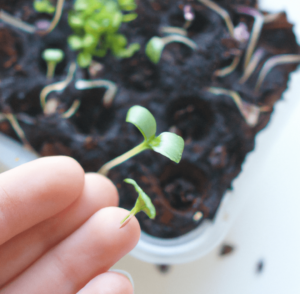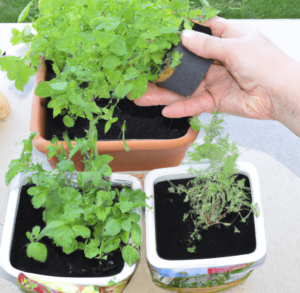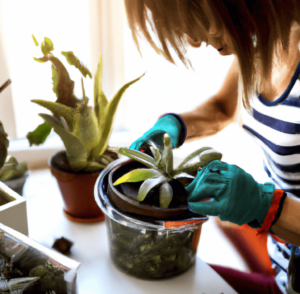In-ground gardening refers to the practice of growing plants in soil that is dug into the ground, as opposed to containers or raised beds. This type of gardening allows plants to develop strong roots, leading to healthier and more robust growth. In this article, we will explore the benefits of in-ground gardening, and provide tips for creating and maintaining an in-ground garden.
The ground is the surface layer of the earth, consisting of soil, rock, and organic matter. It is the foundation for any garden, providing the nutrients and support that plants need to thrive. When preparing the ground for in-ground gardening, it is important to choose a location with well-draining soil and plenty of sunlight.
Plants are living organisms that convert sunlight into energy through a process called photosynthesis. They are essential to in-ground gardening, as they provide the greenery and beauty that makes a garden a welcoming and peaceful space. When selecting plants for your in-ground garden, consider factors such as their size, growth rate, and sunlight and water requirements.
A garden is a planned space, usually outdoors, where plants are grown for aesthetic or recreational purposes. In-ground gardening allows for a greater variety of plants to be grown, as the soil provides more nutrients and support than container or raised bed gardening. By creating an in-ground garden, you can transform a dull outdoor space into a beautiful and productive oasis.
Gardening is the act of cultivating and caring for plants. It can be a relaxing and rewarding hobby, providing physical activity and a sense of accomplishment. In-ground gardening requires some basic knowledge and skills, such as understanding soil composition and plant care, as well as regular maintenance tasks such as watering, weeding, and pruning.
A garden bed is a dedicated area of a garden where plants are grown. In in-ground gardening, a garden bed is created by digging into the ground and preparing the soil for planting. Garden beds can be any size or shape, and can be bordered with edging materials such as wood, stone, or plastic. By dividing your garden into beds, you can create a visually appealing layout and make it easier to manage and care for your plants.
In conclusion, in-ground gardening allows for healthy plant growth and a beautiful outdoor space. By understanding the ground, plants, and gardening techniques, you can create and maintain a thriving in-ground garden.

Pros of Raised Ground
Raised ground can provide a number of benefits in certain situations. Some of the potential advantages of raised ground include:
- Improved drainage: By elevating the ground, water can more easily run off the surface, reducing the risk of standing water and the potential for flooding. This can be especially important in areas that are prone to heavy rainfall or where the local water table is high.
- Enhanced plant growth: Raising the ground can improve the soil quality in the area, allowing for better drainage and more oxygen to reach plant roots. This can result in healthier, more robust plant growth.
- Increased property value: In some cases, raised ground can improve the aesthetic appeal of a property and make it more attractive to potential buyers. This can potentially increase the value of the property.
- Enhanced views: Raised ground can provide a better vantage point for views of the surrounding area. This can be especially beneficial in locations with natural beauty or interesting landscapes.
- Improved accessibility: Raised ground can make it easier for people with mobility issues to access certain areas, as it can reduce the need for stairs or other obstacles. This can make a property more accessible and user-friendly for a wider range of people.
Raised Beds for Gardening
Gardening is a popular hobby for many people, and one way to make it more enjoyable is to use raised beds. Raised beds are elevated areas of ground that are used to plant gardens. These beds are often filled with soil and other materials that are well-suited for growing plants, and they can be a great way to improve the overall health of your garden.
One of the benefits of using raised beds is that they allow you to control the soil quality in your garden. By filling the bed with a mixture of soil, compost, and other organic materials, you can create a nutrient-rich environment that is perfect for growing a wide variety of plants. Raised beds also help to improve drainage, which is important for preventing waterlogged soil and promoting healthy root growth.
Another advantage of raised beds is that they make gardening more accessible. Because the bed is elevated, it is easier to reach and tend to the plants, which can be especially helpful for people who have limited mobility or difficulty bending down. Additionally, raised beds can be a great way to create a more attractive garden, as the elevated beds can be used to add height and interest to your garden design.
Overall, using raised beds for gardening can be a great way to improve the health of your plants and make your gardening experience more enjoyable. Whether you are an experienced gardener or just starting out, raised beds can be a valuable addition to any garden.
Space for In-ground Gardening
Gardening in space presents unique challenges due to the lack of a gravitational pull and the limited area available for growing plants. In order to overcome these challenges, astronauts must use specially designed gardening equipment and techniques. For example, plants may be grown in small containers using soil-less media and artificial lighting. These containers can then be placed in designated areas, or gardens, within the spacecraft.
In order to conserve space and resources, it is important for astronauts to carefully plan and manage their gardens. This may involve selecting appropriate plant species and closely monitoring their growth and health. It is also important to consider the amount of time and effort required for gardening activities, as well as the potential benefits such as providing fresh food and improving the psychological well-being of the crew.
Overall, gardening in space requires a combination of creativity, expertise, and careful planning in order to successfully cultivate plants in the unique environment of a spacecraft.
In-ground Gardening
Gardening often involves working with the ground, whether it is preparing a bed for planting, planting and maintaining a garden, or improving the overall health of the soil. One popular method for gardening is using raised beds, which are essentially boxes or frames built above the ground to create a contained growing space. This can be especially useful for those with limited space, poor soil quality, or mobility issues.
Raised beds allow for better drainage and soil aeration, and can also make it easier to control the type of soil used for planting. For example, many gardeners opt for organic soil, which is free of synthetic chemicals and fertilizers, to promote healthy plant growth and minimize environmental impact.
Working with the ground in a garden can be a rewarding experience, whether you are a seasoned gardener or just starting out. By taking the time to prepare the soil and create a suitable environment for plants, you can enjoy a thriving and productive garden.
Beds
Beds are an essential element in any garden, providing a dedicated space for plants to grow and thrive. Beds can be placed directly on the ground, or they can be raised up off the ground in a structure known as a raised bed. Raised beds are a popular choice for many gardeners because they offer a number of advantages, including improved drainage and easier access for planting and maintenance.
Plants can be arranged in a variety of patterns and designs in beds, depending on the desired aesthetic and the type of plants being grown. Some popular bed styles include formal rows, informal cottage garden arrangements, and even geometric shapes like circles or squares.
No matter the style, properly preparing the bed before planting is crucial for the success of the garden. This often includes removing weeds, amending the soil with compost or other organic matter, and properly spacing the plants to ensure they have enough room to grow and receive adequate sunlight and water.
By taking the time to carefully plan and prepare their beds, gardeners can create beautiful, thriving spaces that provide both aesthetic pleasure and delicious fruits, vegetables, and flowers.
Gardening
Gardening is the practice of growing plants in a specific area, often in the ground or in raised beds. This can be done for a variety of reasons, including for decorative purposes, to produce food, or for environmental conservation. There are many different types of gardens, ranging from small container gardens on a balcony to large, sprawling gardens with a variety of plants.
Regardless of the size or type of garden, one of the key aspects of successful gardening is selecting the right plants for the specific area. This means taking into account the amount of sunlight, moisture, and other factors that will affect the plants’ growth. It also involves choosing plants that are suited to the soil type and pH level, as well as any pests or diseases that may be present in the area.
Raised beds are a popular option for gardeners, as they can provide a number of benefits. These include improved drainage, easier access for planting and maintenance, and the ability to create a more controlled environment for the plants. Raised beds can also be a good option for gardeners with limited space, as they can be built in a variety of shapes and sizes to fit the available area.
Overall, gardening can be a rewarding and enjoyable hobby, providing a sense of accomplishment and a connection to nature. With the right planning and care, even a small garden can provide a bounty of fresh produce or beautiful flowers.
Design
There are many different design options to consider when planning your garden, including the type of soil you use, whether to use raised beds, and what type of flowers to plant. One popular design option is the use of raised beds, which can help improve drainage and soil quality, as well as make it easier to maintain and care for your plants. Raised beds can also add a decorative touch to your garden, and can be made from a variety of materials, such as wood, stone, or even recycled materials.
When designing your raised beds, it is important to consider the cost and overall budget for your project. Raised beds can be a more expensive option than traditional in-ground gardens, but the benefits may be worth the additional cost. It is also important to consider the size and location of your raised beds, as well as the type of plants you will be growing, in order to ensure that they receive the proper amount of sunlight and moisture.
In addition to raised beds, you may also want to consider incorporating other design elements, such as a flower bed or border, to add color and visual interest to your garden. When choosing flowers, it is important to select varieties that are well-suited to your climate and soil type, and that will thrive in the specific conditions of your garden. With careful planning and attention to detail, you can create a beautiful and functional garden design that will provide enjoyment for years to come.
Planting a Garden
Gardening is a popular pastime that allows people to connect with nature and grow their own plants, vegetables, and flowers. One popular method of gardening is using raised beds, which are elevated areas of soil that are separated from the surrounding ground. Raised beds can be especially useful for people with limited space or difficulty bending down to garden in traditional in-ground beds.
To create a raised bed, you will need to choose an area of your yard that receives plenty of sunlight and has well-draining soil. You can purchase raised bed kits or make your own using materials such as wood, bricks, or stones. Once your raised bed is in place, you can fill it with soil and compost, and choose the plants you would like to grow.
Raised beds can be a great option for people who want to garden but may have limited space or mobility. They also provide a more controlled environment for your plants, allowing you to easily manage the soil, watering, and drainage. With a little effort and planning, you can create a beautiful and productive garden using raised beds.

Growing in Raised Beds
Growing plants in raised beds offers a number of benefits. Raised beds are a type of gardening method in which the soil is built up in a rectangular or square bed that is higher than the surrounding ground. This allows for better drainage, improved soil quality, and easier access to the plants for maintenance and harvesting.
One benefit of growing plants in raised beds is that the soil can be easily amended to create the ideal growing conditions for a particular plant. For example, a raised bed can be filled with a mix of compost and soil that is well-suited to growing vegetables, herbs, or flowers. This can help to improve the overall health and productivity of the plants.
Another benefit of raised bed gardening is that it can help to conserve water. Because the soil in a raised bed is higher than the surrounding ground, it is less likely to be compacted and more likely to retain moisture. This means that less water is needed to keep plants hydrated, and the risk of water loss due to evaporation is reduced.
In addition, raised beds can make it easier to control pests and diseases. Because the plants are grown in a contained area, it is easier to monitor for signs of problems and to take action if necessary. This can help to prevent the spread of pests and diseases, and can make it easier to maintain a healthy garden.
Overall, raised bed gardening is a great way to improve the health and productivity of plants, and can provide a number of benefits to the gardener. Whether you are a seasoned gardener or a beginner, raised beds can be a great way to grow a variety of plants and to enjoy the benefits of gardening.
Vegetable in In-ground Gardening
Vegetables are typically grown in a garden by a gardener. The plants are planted in soil, often in a dedicated bed within the garden. Vegetables can be grown from seeds or from starter plants, and require regular watering, fertilizing, and care to thrive. Some common vegetables include tomatoes, carrots, lettuce, potatoes, and peppers. Different vegetables have different growing seasons and requirements, and a skilled gardener can choose the right vegetables to grow in their climate and space.
Bottom Line: In-ground Gardening is the Most Traditional and Common Method of Gardening
In-ground gardening refers to the practice of growing plants directly in the soil in which they are planted. This is the most traditional and common method of gardening, and it involves preparing the soil, choosing the right plants for the location, and providing the necessary care and maintenance to ensure healthy growth. In-ground gardening can be done on a small scale in a backyard or on a larger scale in a farm or community garden. It can be a rewarding hobby that provides both physical exercise and a sense of accomplishment, as well as a source of fresh produce and beautiful plants.
If you’re interested in the in-ground gardening, you may also be interested in hydroponics gardening and keyhole gardening.







